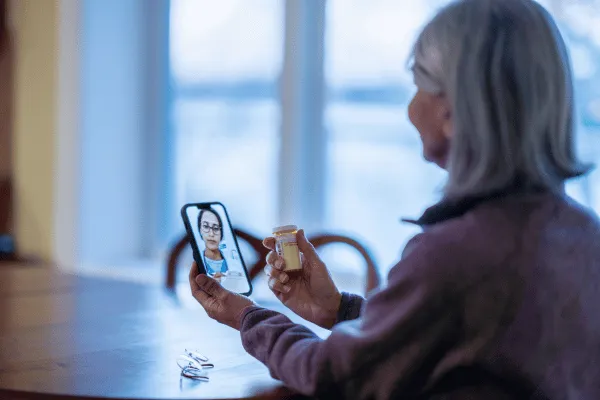Your Guide to Understanding Psoriatic Arthritis
Psoriatic arthritis (PsA) is a condition where our body's immune system mistakenly targets healthy cells, often appearing alongside psoriasis. Beyond skin symptoms, it can impact our joints, internal organs, and even our eyes. It's worth noting that its signs can resemble other conditions, so pinpointing a diagnosis can be a bit of a puzzle.
Navigating life with PsA is a unique journey for everyone. Whether you're new to the diagnosis or have been managing it for some time, having the right information and support is invaluable. Dive into our site for insights on PsA, from understanding the diagnosis to exploring treatments. Alongside, discover tips for daily management, and avenues to advocate not just for yourself but for others too.

Telehealth Follow-Ups Put Spondyloarthritis Patients in the Driver’s Seat
When it comes to managing chronic arthritis, one size does not fit all. A recent study published in The Lancet Rheumatology reveals that giving patients with spondyloarthritis (SpA) more control over their follow-up care through telemedicine can lead to better efficiency and flexibility – cutting down on unnecessary clinic visits and costs without harming health outcomes. This patient-initiated telehealth approach aligns with broader trends in digital health, patient empowerment, and value-based care, suggesting a new model for chronic disease management that benefits both patients and providers.
From Routine Appointments to Patient-Initiated Follow-Up
Traditional rheumatology care often follows a fixed schedule of appointments, which may not always be necessary for every patient. In contrast, patient-initiated follow-up (PIFU) allows individuals to schedule check-ins based on their needs rather than an arbitrary timetable. Telemedicine technologies make this possible by enabling remote consultations and monitoring. For example, a person with stable spondyloarthritis could go months feeling well and only reach out when symptoms flare or questions arise, instead of automatically coming in every few months when it might not be needed.
Asynchronous telemedicine – meaning communication that isn’t in real-time – is a key feature of this model. Instead of always relying on live phone or video calls, patients and providers can use secure messaging, apps, or online forms to exchange information on their own time. For instance, patients might fill out electronic symptom questionnaires or send updates through a portal, and the rheumatology team responds within a set timeframe. This on-demand style of follow-up ensures that care is provided when the patient actually needs it while avoiding the burden of needless visits. Crucially, a safety net is still in place: if a patient doesn’t reach out within a certain period, a routine check is scheduled to make sure nothing is missed. Overall, this approach aims to maintain quality care with greater convenience.
Cutting Unnecessary Visits without Sacrificing Quality
The Dutch “TeleSpA” trial put this idea to the test in real-world practice. About 200 patients with stable spondyloarthritis were enrolled and randomly assigned to either the new PIFU telemedicine model or to continue with usual scheduled care. Over one year, the results were striking: the telemedicine group needed only about 1.9 rheumatology visits on average, compared to 2.6 visits for those receiving standard routine care – a roughly 25% reduction in clinic visits. In other words, many appointments that would have been routine turned out not to be needed when patients had the option to follow up only as necessary. Importantly, this reduction in visits did not come at the expense of patient health. The study reported no decline in quality-adjusted life years (QALYs) – a measure of both the quantity and quality of life – for the telehealth group, indicating that patients remained just as healthy and satisfied as those in usual care. Rates of adverse events were low and comparable between groups, suggesting that monitoring via telemedicine was just as safe as in person surveillance.
These findings underscore that for well-managed cases, less can be more. By sparing patients needless trips to the clinic when they’re doing fine, the healthcare system can focus resources where they’re truly needed. As one commentary noted, a patient-initiated telemedicine approach “reduces hospital visits, and ensures timely and personalised care for those in most need. Patients get seen at the right time – when they feel they need help – rather than filling up the schedule with perfunctory check-ins.
Key Outcomes from the TeleSpA Study.
25% Fewer Clinic Visits: Patients using on-demand telehealth follow-up averaged 1.9 rheumatology visits in a year vs. 2.6 with standard scheduled care (a significant drop in unnecessary appointments).
Health Outcomes Maintained: There was no loss of quality-adjusted life years for the telemedicine group, meaning their quality of life and disease control were just as good as those with regular appointments
Cost Savings: Fewer visits translated to about €180 lower healthcare costs per patient per year in the telemedicine group (from the healthcare system perspective). When also considering patient time, travel expenses, and work productivity, the overall cost-effectiveness of the approach became even more evident.
Comparable Safety: Both groups had minimal disease complications and similar safety outcomes, indicating that reducing in-person visits did not compromise patient safety
Lower Costs and Greater Flexibility for All
One of the most exciting implications of this study is the potential to lower healthcare costs and resource burden while keeping patients healthier. In an era of rising medical costs and clinician workforce shortages, trimming a quarter of routine visits – with no drop in care quality – is a huge win. For healthcare systems, this means saved clinic slots and provider time that can be redirected to patients who truly need in-person attention. In fact, experts suggest that such models could help ease pressure on overburdened rheumatology clinics and address workforce limitations by making follow-up care more efficient
Patients, too, stand to benefit financially and practically. Fewer clinic visits mean less money spent on copays, travel, and time off work. Spondyloarthritis often affects people in their working years, so avoiding an unnecessary half-day off for a routine check not only saves personal time but also reduces lost productivity. Qualitative research following the trial found that patients appreciated the time savings and felt more in control of managing their condition. With the telemedicine setup, they could quickly reach out when something was wrong, giving them peace of mind that help was a click away while not having to attend appointments when everything was stable. This boosted patients’ confidence and self-management, as many reported better insight into their disease and improved self-efficacy in handling flare-ups.
Providers experienced benefits as well. Rheumatologists and nurses involved in the PIFU program noted greater flexibility in their schedule. Instead of a packed clinic list full of routine check-ins, their time freed up to focus on patients who most needed attention or to accommodate urgent consults. In the long run, this flexibility can improve job satisfaction and reduce burnout by making workloads more manageable. It’s a clear example of how value-based care principles can work in practice – achieving equal or better outcomes for patients at lower cost and with more efficient use of providers’ time. As healthcare shifts away from fee-for-service toward outcome-driven models, such telehealth-enabled efficiencies are exactly what the system is looking for.
Digital Health, Patient Empowerment, and the Future of Arthritis Care
The success of patient-initiated telemedicine follow-up in SpA is part of a bigger trend in healthcare: leveraging digital tools to empower patients and deliver care that’s more personalized, convenient, and cost-effective. Telehealth usage skyrocketed during the COVID-19 pandemic and has since become an indispensable part of chronic disease management. For people with arthritis – whether spondyloarthritis, rheumatoid arthritis, or other forms – telemedicine offers a way to stay connected with healthcare teams without the hassle of frequent travel. Remote monitoring technologies (like apps for symptom tracking or wearable devices) can continuously keep an eye on patient well-being, alerting providers only when intervention might be needed.This proactive, patient-centered approach aligns with the concept of patients as partners in their care. Indeed, studies indicate that patients appreciate the flexibility and active role they have under a PIFU, which can increase satisfaction and engagement.
Moreover, these findings fit squarely into the push for value-based care – a healthcare approach that incentivizes better health outcomes for patients relative to the cost of achieving those outcomes. Reducing routine visits while maintaining quality is essentially improving the “value” delivered to patients. Payers and providers are increasingly interested in such strategies that can curb unnecessary utilization and spend more time on interventions that make a real difference. By using telehealth to deliver follow-up care only when needed, the system avoids wasted resources on low-value visits and devotes attention to delivering timely care in a more responsive way. The result is a win-win: patients get more autonomy and convenience, and healthcare systems improve efficiency and outcomes.
Of course, patient-initiated telemedicine follow-up isn’t a one-size-fits-all solution. It works best for patients with stable disease and adequate health literacy and technology access. Those with very active disease, complex conditions, or limited ability to engage via technology may still require regular scheduled visits and support. Careful triage is essential to ensure no patient falls through the cracks – for example, newly diagnosed or high-risk patients might need closer monitoring until they reach stability. Health systems adopting this model are advised to maintain a safety net (such as periodic check-ins if someone doesn’t initiate follow-up) and provide extra assistance to patients who need help with digital tools. When implemented thoughtfully, however, patient-driven follow-up can enhance equity and outcomes by allocating care according to individual need rather than a rigid timetable.
A Promising Model for Value-Based Arthritis Care
The findings from the Lancet Rheumatology study offer a promising glimpse into the future of arthritis care. A telemedicine-supported, patient-initiated follow-up model can empower patients, improve quality of life, and make better use of healthcare resources. In spondyloarthritis, it achieved these goals without any loss of health or safety – and with clear cost savings. This approach dovetails with the Arthritis Foundation’s mission to advance patient-centered solutions that improve outcomes and quality of care.
As healthcare continues to evolve, we may see broader adoption of “on-demand” follow-up care for various chronic conditions. For arthritis patients, that means greater freedom to manage your condition on your own terms, knowing that your care team is available when you truly need them. At the same time, clinics can operate more efficiently, and providers can spend time where it matters most. In an era focused on value, outcomes, and patient empowerment, the TeleSpA study demonstrates that telemedicine-enabled PIFU is not just a theoretical ideal – it can be a practical, win-win strategy for delivering high-quality arthritis care. By embracing such innovative models, we move closer to a future where managing chronic arthritis is more responsive, sustainable, and attuned to each patient’s life.
Sources:
Hermans K. et al. The Lancet Rheumatology – Patient-initiated telemedicine follow-up vs. usual care in spondyloarthritis (TeleSpA trial)
The Lancet Rheumatology (Editorial) – “Patient-initiated follow-up: leave no one behind”thelancet.comthelancet.com
Smits M.L. et al. Rheumatology (Oxford) – Patient and provider experiences with PIFU in SpA
Mahalo Health – Digital health and value-based care insightsmahalo.health

Have a question?
We're Here to Help
By providing my phone number, I agree to receive text messages from the business.


